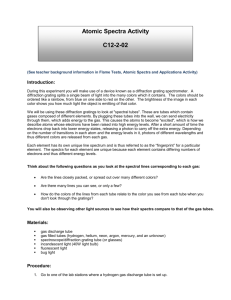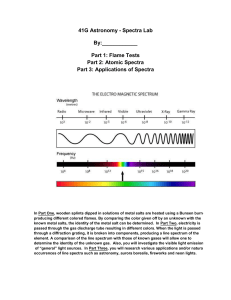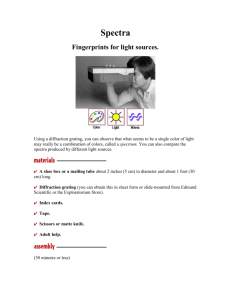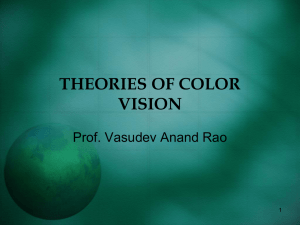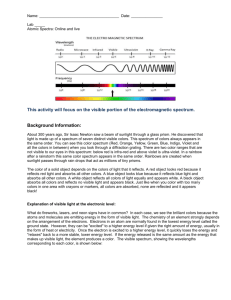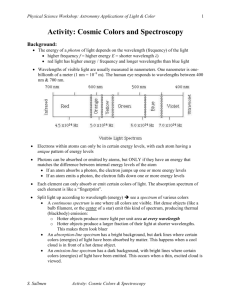Atomic Fingerprint Lab
advertisement
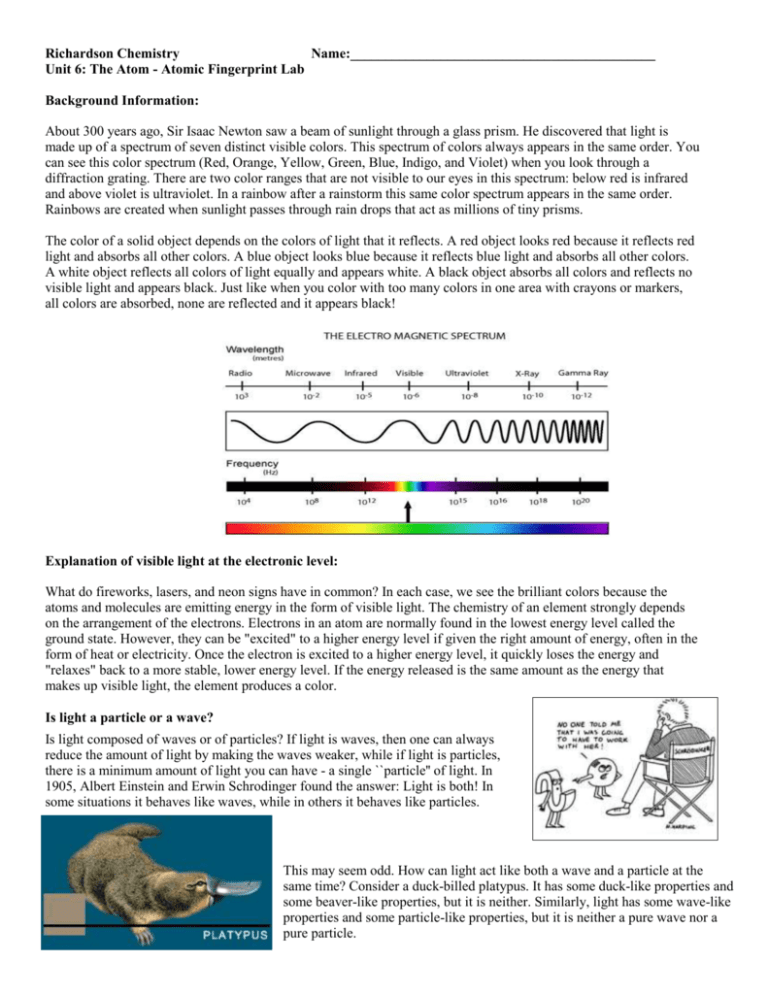
Richardson Chemistry Name:____________________________________________ Unit 6: The Atom - Atomic Fingerprint Lab Background Information: About 300 years ago, Sir Isaac Newton saw a beam of sunlight through a glass prism. He discovered that light is made up of a spectrum of seven distinct visible colors. This spectrum of colors always appears in the same order. You can see this color spectrum (Red, Orange, Yellow, Green, Blue, Indigo, and Violet) when you look through a diffraction grating. There are two color ranges that are not visible to our eyes in this spectrum: below red is infrared and above violet is ultraviolet. In a rainbow after a rainstorm this same color spectrum appears in the same order. Rainbows are created when sunlight passes through rain drops that act as millions of tiny prisms. The color of a solid object depends on the colors of light that it reflects. A red object looks red because it reflects red light and absorbs all other colors. A blue object looks blue because it reflects blue light and absorbs all other colors. A white object reflects all colors of light equally and appears white. A black object absorbs all colors and reflects no visible light and appears black. Just like when you color with too many colors in one area with crayons or markers, all colors are absorbed, none are reflected and it appears black! Explanation of visible light at the electronic level: What do fireworks, lasers, and neon signs have in common? In each case, we see the brilliant colors because the atoms and molecules are emitting energy in the form of visible light. The chemistry of an element strongly depends on the arrangement of the electrons. Electrons in an atom are normally found in the lowest energy level called the ground state. However, they can be "excited" to a higher energy level if given the right amount of energy, often in the form of heat or electricity. Once the electron is excited to a higher energy level, it quickly loses the energy and "relaxes" back to a more stable, lower energy level. If the energy released is the same amount as the energy that makes up visible light, the element produces a color. Is light a particle or a wave? Is light composed of waves or of particles? If light is waves, then one can always reduce the amount of light by making the waves weaker, while if light is particles, there is a minimum amount of light you can have - a single ``particle'' of light. In 1905, Albert Einstein and Erwin Schrodinger found the answer: Light is both! In some situations it behaves like waves, while in others it behaves like particles. This may seem odd. How can light act like both a wave and a particle at the same time? Consider a duck-billed platypus. It has some duck-like properties and some beaver-like properties, but it is neither. Similarly, light has some wave-like properties and some particle-like properties, but it is neither a pure wave nor a pure particle. Types of Spectra: Scientist use three basic types of spectra. Examples are shown below: Type of Spectrum Photographic example Continuous (or continuum) Absorption (dark line) Emission (bright line) Atomic Spectra: The important thing to know about absorption and emission spectra is that every atom of a particular element will have the same pattern of lines all the time. And the spacing of the lines is the same in both absorption and emission spectra. During this experiment you will make use of a device known as a diffraction grating spectrometer. A diffraction grating splits a single beam of light into the many colors which it contains. The colors should be ordered like a rainbow, from blue on one side to red on the other. The brightness of the image in each color shows you how much light the object is emitting of that color. We will be using these diffraction gratings to look at "spectral tubes". These are tubes which contain gases composed of different elements. By plugging these tubes into the wall, we can send electricity through them, which adds energy to the gas. This causes the atoms to become "excited", which is how we describe atoms whose electrons have been raised into high energy levels. After a short amount of time the electrons drop back into lower energy states, releasing a photon to carry off the extra energy. Depending on the number of transitions in each atom and the energy levels in it, photons of different wavelengths and thus different colors are released from each gas. Each element has its own unique line spectrum and is thus referred to as the “fingerprint” for a particular element. The spectra for each element are unique because each element contains differing numbers of electrons and thus different energy levels. Think about the following questions as you look at the spectral lines corresponding to each gas: Are the lines closely packed, or spread out over many different colors? Can you see many lines, or only a few? How do the colors of the lines from each tube relate to the color you see from each tube when you don't look through the gratings? Procedure: 1. Hold the spectrometer so the diffraction slit is towards the light source and the diffraction grating (window) is towards you. 2. When the electricity is turned on, make observations of the color given off by the gas. Record your observations. 3. Look through the diffraction grating and observe and record the colored lines (spectrum) produced by the various gases. Record only one set of colors. Complete the data table below and then draw the color lines in the spectrum boxes that follow. 4. Repeat for each element provided as well as the unknown chemicals. Data: Table 1: The Color of the Discharge Tube & Number of Lines in the Spectrum of Various Elements and Compounds Color of the Number of Different Discharge Tube Colored Lines In the Spectrum Hydrogen Oxygen Nitrogen Helium Neon Argon Krypton Iodine Carbon Dioxide Unknown Draw a detailed view of the spectra (including approximate wavelengths) observed below: Hydrogen Oxygen Nitrogen Helium Neon Argon Krypton Iodine Carbon dioxide Unknown 5. Now investigate indirect sunlight (Never look directly at the sun!) and fluorescent lights and record what is observed in the second data table below. 6. Draw a detailed view of all spectra observed in the spectrum boxes. Table 2: Spectra of Indirect Sunlight and Fluorescent Light Color of Light Source Type of Spectrum Indirect Sunlight Fluorescent Light Sunlight Fluorescent Analysis: Please give detailed responses, and use grammatically correct English sentences. 1. What is the difference between a line spectrum and a continuous spectrum? Provide an example of each. 2. Each line in the emission spectrum of the hydrogen corresponds to an electromagnetic radiation with a specific wavelength. Match the 4 observed colors with the following wavelengths: 410 nm, 434 nm, 486 nm, and 656 nm. 3. What do the different colors in a line spectrum represent? Why are the spectra for each element unique? 4. Which element produced the largest number of lines? Which element produced the smallest number of lines? Explain why elements produce different numbers of spectral lines. 5. Use the ACE Rubric to answer the following question. What gas do you think is found in the unknown?
